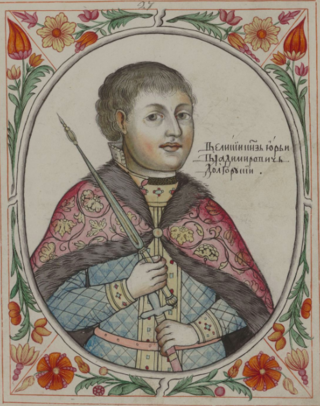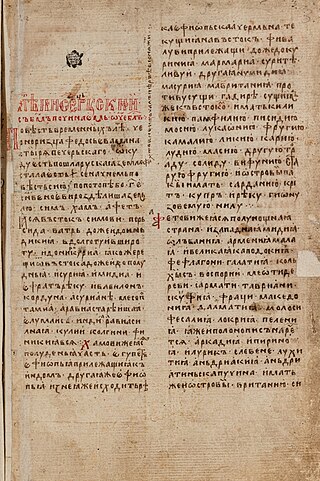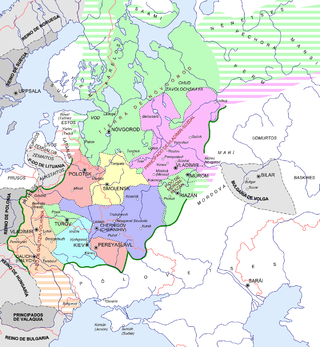
The Russian Primary Chronicle, commonly shortened to Primary Chronicle, is a chronicle of Kievan Rus' from about 850 to 1110. It is believed to have been originally compiled in or near Kiev in the 1110s. Tradition ascribed its compilation to the monk Nestor beginning in the 17th century, but this is no longer believed to have been the case.

Yuri I Vladimirovich, commonly known as Yuri Dolgorukiy or the Long Arm, was a Monomakhovichi prince of Rostov and Suzdal, acquiring the name Suzdalia during his reign. Noted for successfully curbing the privileges of the landowning boyar class in Rostov-Suzdal and his ambitious building programme, Yuri transformed this principality into the independent power that would evolve into early modern Muscovy. Yuri Dolgorukiy was the progenitor of the Yurievichi, a branch of the Monomakhovichi.

The Principality or, from 1253, Kingdom of Galicia–Volhynia historically known as the Kingdom of Ruthenia was a medieval state in Eastern Europe which existed from 1199 to 1349. Its territory was predominantly located in modern-day Ukraine, with parts in Belarus, Poland, Moldova, and Lithuania. Along with Novgorod and Vladimir-Suzdal, it was one of the three most important powers to emerge from the collapse of Kievan Rus'. The main language was Old East Slavic, the predecessor of the modern East Slavic languages, and the official religion was Eastern Orthodoxy.

Andrey Bogolyubsky, was Grand Prince of Vladimir from 1157 until his death. During repeated internecine wars between the princely clans, Andrey accompanied his father Yuri Dolgorukiy during a brief capture of Kiev in 1149; 20 years later, he led the Sack of Kiev (1169), and made efforts to elevate Vladimir on the Klyazma as the new capital of Kievan Rus'. He was canonized as a saint in the Russian Orthodox Church in 1702.

Mikhail Vsevolodovich, known as Michael or Mikhail of Chernigov, was Grand Prince of Kiev ; he was also Prince of Pereyaslavl (1206), Novgorod-Seversk (1219–1226), Chernigov, Novgorod, and Galicia (1235–1236).

The Galician–Volhynian Chronicle (GVC), also known as Chronicle of Halych–Volhynia and The Dynastic Chronicle of the Romanovichi, is a prominent work of Old Ruthenian literature and historiography covering 1201–1292 in the history of the Principality of Galicia–Volhynia.

The Hypatian Codex is a compendium of three Rus' chronicles: the Primary Chronicle, Kievan Chronicle and Galician-Volhynian Chronicle. It is the most important source of historical data about Kievan Rus'. The language of this work is Old Church Slavonic with many East Slavisms.

Roman Mstislavich, also known as Roman the Great, was Prince of Novgorod (1168–1170), Volhynia, and Galicia. He founded the Romanovichi branch of Rurikids, which would rule Galicia–Volhynia until 1340.

The Principality of Halych, or Principality of Halychian Rus', was a medieval East Slavic principality, and one of the main regional states within the political scope of Kievan Rus', established by members of the oldest line of Yaroslav the Wise descendants. A characteristic feature of the Halych principality was the important role of the nobility and citizens in political life, and consideration a will which was the main condition for the princely rule. Halych as the capital mentioned in around 1124 as a seat of Ivan Vasylkovych the grandson of Rostislav of Tmutarakan. According to Mykhailo Hrushevsky the realm of Halych was passed to Rostyslav upon the death of his father Vladimir Yaroslavich, but he was banished out of it later by his uncle to Tmutarakan. The realm was then passed to Yaropolk Izyaslavich who was a son of the ruling Grand Prince Iziaslav I of Kiev.

The inner Principality of Kiev was a medieval East Slavic state, situated in central regions of modern Ukraine around the city of Kiev.
The Prince of Pereyaslavl was the ruler of the Principality of Pereyaslavl, a lordship based on the city of Pereyaslavl on the Trubezh River, and straddling extensive territory to the east in what are now parts of Ukraine. It was situated on the southern frontier of Kievan Rus' and bordered the steppe.

Yaropolk Iziaslavich was Prince of Turov and Prince of Volhynia from 1078 until his death.

The Rurik dynasty, also known as the Rurikid or Riurikid dynasty, as well as simply Rurikids or Riurikids, was a noble lineage allegedly founded by the Varangian prince Rurik, who, according to tradition, established himself at Novgorod in the year 862. The Rurikids were the ruling dynasty of Kievan Rus' and its principalities following its disintegration.

The siege of Kiev by the Mongols took place between 28 November and 6 December 1240, and resulted in a Mongol victory. It was a heavy morale and military blow to the Principality of Galicia–Volhynia, which was forced to submit to Mongol suzerainty, and allowed Batu Khan to proceed westward into Central Europe.
Vladimir II Yaroslavich was a Rus’ prince. He was prince of Halych.
Andrew of Hungary was Prince of Halych–Volhynia between 1227 and 1230, and between 1231 and 1234, and Prince of Zvenyhorod in 1226.

The sack of Kiev took place on 8–12 March 1169 when a coalition of 11 princes, assembled by prince Andrey Bogolyubsky of Vladimir-Suzdal, attacked the Kievan Rus' capital city of Kiev during the 1167–1169 Kievan succession crisis. The conflict, caused by the death of grand prince Rostislav I of Kiev, was between rival branches of the Monomakhovichi clan: the Iziaslavichi of Volhynia on the one hand, and the Rostislavichi of Smolensk, the Yurievichi, and the Olgovichi of Chernigov on the other. Prince Mstislav II of Kiev sought to defend Kiev against the Rostislavichi–Yurievichi–Olgovichi coalition.

The Khlebnikov Codex is a codex of Rus' chronicles compiled in the 1560s.
Textual criticism or textology of the Primary Chronicle or Tale of Bygone Years aims to reconstruct the original text by comparing extant witnesses. This has included the search for reliable textual witnesses ; the collation and publication of such witnesses; the study of identified textual variants ; discussion, development and application of methods according to which the most reliable readings are identified and favoured of others; and the ongoing publication of critical editions in pursuit of a paradosis.
The Suzdalian Chronicle, also known as the Chronicle of Vladimir-Suzdal, Suzdal–Vladimirian Chronicle or Laurentian–Radziwiłł–Academic Chronicle (LRAC), is a Rus' chronicle. It is one of several continuations of the Primary Chronicle (PVL).

















